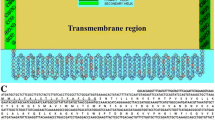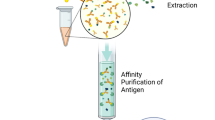Abstract
Angistrongylus cantonensis is a zoonotic nematode parasite and causative agent of human angiostrongyliasis, which clinically presents as eosinophilic meningitis or meningoencephalitis. Diagnosis of the disease is problematic since parasitologic findings are infrequent, and infection determinations must be based on the clinical symptoms and serological tests with limited specificities and sensitivities. The aim of the present study was to identify and generate a novel recombinant protein from A. cantonensis and evaluate its efficacy in the diagnosis of human angiostrongyliasis when incorporated into a Western blot serodiagnostic system. A cDNA protein expression library from adult A. cantonensis was constructed, followed by immunoscreening with serum from confirmed infected patients to identify and isolate immunoreactive clones. One clone, designated fAC40, possessed a partial sequence encoding a LisH protein domain with a predicted molecular weight of 16 kDa and containing four predicted antigenic peptides. By incorporating recombinant fAC40 in Western immunoblot tests using a serum panel consisting of confirmed and clinically diagnosed cases of human angiostrongyliasis and other helminthic infections, fAC40 exhibited a sensitivity and specificity of 91.8 and 100 %, respectively, and a positive and negative predictive value of 100 and 97.19 %, respectively, in the diagnosis of angiostrongyliasis. Importantly, it was not reactive with antibodies from serum of patients infected with Gnathostoma spinigerum and Cysticercus cellulosae, infections that clinically present neurological symptoms similar to angiostrongyliasis. These data demonstrate that the 16-kDa recombinant protein from A. cantonensis possesses high potential as a candidate antigen for a more sensitive and specific serodiagnosis of human angiostrongyliasis.



Similar content being viewed by others
References
Bhaibulaya M (1991) Snail borne parasitic zoonoses: Angiostrongyliasis. Southeast Asian J Trop Med Public Health 22(Suppl):189–193
Cheng M, Yang X, Li Z, He H, Qu Z, He A, Wu Z, Zhan X (2012) Cloning and characterization of a novel cathepsin B-like ctsteine proteinase from Angiostrongylus cantonensis. Parasitol Res 110:2413–2422
Chotmongkol V, Sawanyawisuth K (2002) Clinical manifestations and outcome of patients with severe eosinophilic meningitis presumably caused by Angiostrongylus cantonensis. Southeast Asian J Trop Med Public Health 33:231–234
Cross JH, Chen ER (2007) Angiostrongyliasis. In: Murrell KD, Fried B (ed) Food-borne parasitic zoonoses. Springer US, pp 263-290
Dekumyoy P, Komalamisra C, Nuamtanong S, Nacapunchai D, Sinnawong M, Shanaha P, Piyasatittam P (2000) Angiostrongyliasis: analysis of antigens of Angiostrongylus costaricensis adult worms versus IgG from infected patients with Angiostrongylus cantonensis. Southeast Asian J Trop Med Public Health 31(Suppl):48–53
Deng ZH, Lv S, Lin JY, Lin RX, Pei FQ (2011) An outbreak of angiostrongyliasis in Guanging, People’s Republic of China: migrants vulnerable to an emerging disease. Southeast Asian J Trop Med Public Health 42:1047–1053
Eamsobhana P (2006) The rat lungworm Parastrongylus cantonensis. Wankaew (IQ) Book Center Co. ltd, Bangkok
Eamsobhana P, Yoolek A, Punthuprapasa P, Suvouttho S (2004) A dot-blot ELISA comparable to immunoblot for the specific diagnosis of human parastrongyliasis. J Helminthol 78:287–291
Galen RS (1979) The predictive value of laboratory testing. Orthop Clin North Am 10:287–297
Han YP, Li ZY, Li BC, Sun X, Zhu CC, Ling XT, Zheng HQ, Wu ZD, Lv ZY (2011) Molecular cloning and characterization of a cathepsin B from Angiostrongylus cantonensis. Parasitol Res 109:369–378
Hokke CH, Deelder AM, Hoffmann KF, Wuhrer M (2007) Glycomics-driven discoveries in schistosome research. Exp Parasitol 117:275–283
Intapan PM, Maleewong W, Polsan Y, Sawanyawisuth K, Chotmongkol V (2002) Specific IgG antibody subclasses to Angiostrongylus cantonensis in patients with angiostrongyliasis. Asian Pac J Allergy Immunol 20:235–240
Intapan PM, Maleewong W, Sawanyawisuth K, Chotmongkol V (2003) Evaluation of human IgG subclass antibodies in the serodiagnosis of angiostrongyliasis. Parasitol Res 89:425–429
Lai CH, Yen CM, Chin C, Chung HC, Kuo HC, Lin HH (2007) Eosinophilic meningitis caused by Angiostrongylus cantonensis after ingestion of raw frog. Am J Trop Med Hyg 76:399–402
Li ZY, Lv ZY, Wei J, Liao Q, Zheng HQ, Wu ZD (2012) Clonging and characterization of a novel encoding 16 kDa protein (Ac16) from Angiostrongylus cantonensis. Parasitol Res 110:2145–2153
Liu Q, Yang X, Zhan M, Wang L, Liu J, Chen J, He A, Li Z, Wu Z, Zhan X (2012) Molecular characterization and immunolocalization of a protein disulfide isomerase from Angiostrongylus cantonensis. Parasitol Res 110:2501–2507
Liu YH, Han YP, Li ZY, Wei J, He HJ, Xu CZ, Zheng HQ, Zhan XM, Wu ZD, Lv ZY (2010) Molecular cloning and characterization of cystatin, a cysteine protease inhibitor, from Angiostrongylus cantonensis. Parasitol Res 107:915–922
Lv S, Zhang Y, Chen SR, Wang LB, Fang W, Chen F, Jiang JY, Li YL, Du ZW, Zhou XN (2009) Human angiostrongyliasis outbreak in Dali, China. PLoS Negl Trop Dis 3:e520. doi:10.1371/journal.pntd.0000520
Lv S, Zhang Y, Steinmann P, Zhou XN (2008) Emerging angiostrongyliasis in mainland China. Emerg Infect Dis 14:161–164
Maleewong W, Sombatsawat P, Intapan PM, Wongkham C, Chotmongkol V (2001) Immunoblot evaluation of the specificity of the 29-kDa antigen from young adult female worms Angiostrongylus cantonensis for immunodiagnosis of human angiostrogyliasis. Asian Pac J Allergy Immunol 19:267–273
Nuamtanong S (1996) The evaluation of the 29 and 31 kDa antigents in female Angiostrongylus cantonensis for serodiagnosis of human angiostrongyliasis. Southeast Asian J Trop Med Public Health 27:291–296
Panackel C, Cherian G, Vijayakumar K, Sharma RN (2006) Eosinophilic meningitis due to Angiostrongylus cantonensis. Indian J Med Microbiol 24:220–221
Prasanphanich NS, Mickum ML, Heimburg-Molinaro J, Cummings RD (2013) Glycoconjugates in host-helminth interactions. Front Immunol 4:240. doi:10.3389/fimmu.2013.00240
Punyagupta S (1979) Angiostrongyliasis: clinical features and human pathology. In: Cross JH (ed) Studies on angiostrongyliasis in Eastern Asia and Australia. NAMRU-2-SP-44. Taipei. U.S. Army Medical Research Unit No. 2, Taiwan, pp 138–150
Slom TJ, Cortese MM, Gerber SI, Jones RC, Holtz TH, Lopez AS, Zambrano CH, Sufit RL, Sakolvaree Y, Chaicumpa W, Herwaldt BL, Johnson S (2002) An outbreak of eosinophilic meningitis caused by Angiostrongylus cantonensis in travelers returning from the Caribbean. N Engl J Med 346:668–675
Tesana S, Srisawangwong T, Sithithaworn P, Laha T, Andrews R (2009) Prevalence and intensity of infection with third stage larvae of Angiostrongylus cantonensis in mollusks from Northeast Thailand. Am J Trop Med Hyg 80:983–987
Thiengo S, Simoes RO, Fernandez MA, Maldonado A Jr (2013) Angiostrongylus cantonensis and rat lungworm disease in Brazil. Hawaii J Med Publ Health 72(Suppl 2):18–22
Tsai HC, Lee SS, Huang CK, Yen CM, Chen ER, Liu YC (2004) Outbreak of eosinophilic meningitis associated with drinking raw vegetable juice in southern Taiwan. Am J Trop Med Hyg 71:222–226
van Die I, Cummings RD (2010) Glycan gimmickry by parasitic helminths: a strategy for modulating the host immune response? Glycobiology 20:2–12
Veríssimo CM, Morassutti AL, von Itzstein M, Sutov G, Hartley-Tassell L, McAtamney S, Dell A, Haslam SM, Graeff-Teixeira C (2016) Characterization of the N-glycans of female Angiostrongylus cantonensis worms. Exp Parasitol 166:137–143
Vitta A, Yoshino TP, Kalambaheti T, Komalamisra C, Waikagul J, Ruangsittichai J, Dekumyoy D (2010) Application of recombinant SMR-domain containing protein of Angiostrongylus cantonensis in immunoblot diagnosis of human angiostrongyliasis. Southeast Asian J Trop Med Public Health 41:785–799
Walden H, Slapcinsky J, Qvarnstrom Y, McIntosh A, Bishop H, Rosseland B (2015) Angiostrongylus cantonensis in introduced gastropods in south Florida. J Parasitol 101:156–159
Wang J, Qi H, Diao Z, Zheng X, Li X, Ma S, Ji A, Yin C (2010) An outbreak of angiostrongyliasis cantonensis in Beijing. J Parasitol 96:377–381
Wang QP, Chen XG, Lun ZR (2007) Invasive freshwater snail, China. Emerg Infect Dis 13:1119–1120
Wang QP, Lai DH, Zhu XQ, Chen XG, Lun ZR (2008) Human angiostrongyliasis. Lancet Infect Dis 8:621–630
Yang X, Li Z, He H, Chen M, Liu Q, Zhang D, Chen J, Wu X, He A, Zheng X, Wu Y, Wu Z, Zhan X (2013) Molecular cloning, expression, and characterization of a putative activation-associated secreted protein from Angiostrongylus cantonensis. Parasitol Res 112:781–788
Yen CM, Chen ER (1991) Detection of antibodies to Angiostrongylus cantonensis in serum and cerebrospinal fluid of patients with eosinophilic meningitis. Int J Parasitol 21:17–21
Yii CY (1976) Clinical observations on eosinophilic meningitis and meningoencephalitis caused by Angiostrongylus cantonensis on Taiwan. Am J Trop Med Hyg 25:233–249
Zhou Z, Barennes H, Zhou N, Ding L, Zhu YH, Strobel M (2009) Two outbreaks of eosinophilic meningitis in Yunann (China) clinical, epidemiological and therapeutical issues. Bull Soc Pathol Exot 102:75–80
Acknowledgments
This research was supported by the Commission on Higher Education, Ministry of Education, Thailand. We would like to thank the staff of the Department of Helminthology, Faculty of Tropical Medicine, Mahidol University, Thailand, and the Department of Pathobiological Sciences, School of Veterinary Medicine, The University of Wisconsin-Madison, USA, for providing the laboratory facilities and assistance with the laboratory techniques.
Author information
Authors and Affiliations
Corresponding authors
Ethics declarations
Ethical statement
In the present study, we used laboratory-reared rats as experimental definitive hosts for A. cantonensis. The experiments involving the use of animals were approved by the Animal Care and Use Committee (project no. FTM-ACUC 009/2007) from the faculty of Tropical Medicine, Mahidol University, while those incorporating the use of human serum were approved by the Human Ethics Committee (project no. TMEC09-017).
Rights and permissions
About this article
Cite this article
Vitta, A., Dekumyoy, P., Komalamisra, C. et al. Cloning and expression of a 16-kDa recombinant protein from Angiostrongylus cantonensis for use in immunoblot diagnosis of human angiostrongyliasis. Parasitol Res 115, 4115–4122 (2016). https://doi.org/10.1007/s00436-016-5184-1
Received:
Accepted:
Published:
Issue Date:
DOI: https://doi.org/10.1007/s00436-016-5184-1




